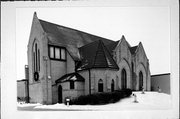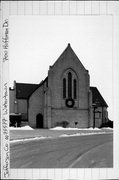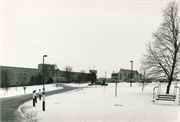| Additional Information: | This chapel was erected on the grounds of the Bethesda Lutheran Home for the mentally retarded in 1936. It is the only remaining historic building on the site.
The Bethesda Lutheran Home was an outgrowth of the charitable works of the Lutheran-related Children's Friend of Kindefreund Societies. The group chose Watertown for the site of the home because of a promise of 20 acres of free land at the southwestern edge of town. However, the first home for Besthesda was at rented quarters at 222-226 Margaret St. The home was located here between 1903 and 1906. When their lease on this location expired, the group moved the home to Milwaukee until 1909, when they returned to Watertown and built on the land originally promised to them. The home also acquired an additional 80 acres of land at that time. Between 1909 and 1936, the home grew in buildings and acres. Eventually the home had several utility buildings, a main building, dormitory, industrial building, isolation hospital, and chapel as part of its campus. Between 1936 and the present time, all historic buildings on the site have been demolished and replaced with large brick and concrete modern institutional buildings. Only the chapel, which is attached to one of the modern buildings remains relatively intact.
The chapel at the Bethesda Lutheran Home has some local historical interest as the only remaining historic building on the grounds of the home.
The establishment of the Bethesda Lutheran Home at Watertown was a significant event for the community. While the 20 acres of free land probably helped sway the decision to locate the home at Watertown, the fact that there was a considerable German settlement there and a significant group of Lutherans was probably also a factor in the decision. The Bethesda Home represents the efforts of the private sector to provide facilities for the poor and disadvantaged, facilities that augment state-run institutions in Wisconsin. It is unfortunate, though, that all the historic buildings on this site have been demolished. It is somewhat interesting that the chapel is the only historic building left of this religious institution. Because the first location of the home on Margaret Street is still extent, the chapel takes on less historic significance next to the original site. Should the Margaret Street location be lost, the chapel might have more significance as the last remaining resource of this important insitution that provided and provides services for handicapped citizens of our society.
Surrounded by a complex of modern brick and concrete buildings in the Bethesda complex, this 20th century late Gothic Revival styled chapel exhibits a simplified form that features dentil trim under the eaves, smooth surfaces artiuclated by simple pointed arched stained glass windows recessed in the plain brick elevations. The windows and arches aer outlined with a simple raised brick border. Stepped buttresses on the corner of the facade and on the elevations of the three-sided side capel also artiuclate the surface. Paired gable rofoed transepts and the side chapel as well as a side entrance vestibule project from the north side of the Bethesda chapel. A panel of stucco and half-timber trim is located directly under the eaves on the north and south elevation. A shed roofed entrance on the south side features a pointed arched entrance door.
Built in 1936 at a cost of $26,000, the Bethesda Chapel originally was designed with an open balcony for wheelchairs and was equipped with a Wangerin organ.
The Bethesda Chapel is significant under Criterion C as an example of late Gothic Revival architecture. One of three well-preserved examples of Gothic styled church architecture designed in the early 20th century in Watertown, the Bethesda Chapel exhibits the simpler surfaces and form of the late Gothci style and the steep gable roofs, pointed arched windows and picturesque appearance associated with all Gothic Revival designs. The other well-preserved examples of early 20th century Gothic Revival Churches are the First Baptist Church at 315 So. 5th (41-8) and the Moravian Church at 510 Cole (49-22). Although this 1936 chapel barely meets the 50 years of age criteria for the NRHP, the Bethesda Chapel is clearly a candidate for nomination in the near future. |
|---|



